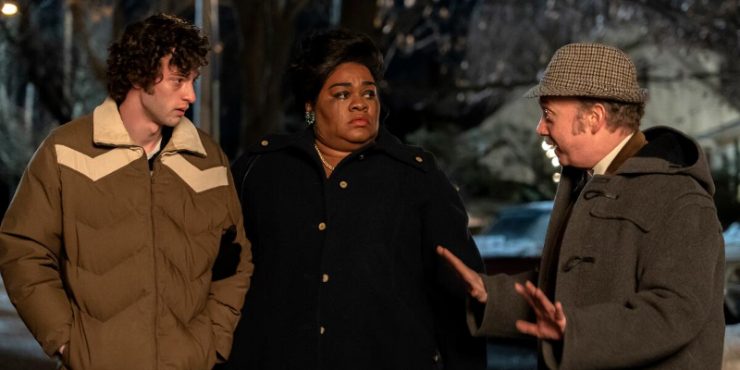It’s been nineteen years since Alexander Payne and Paul Giamatti collaborated on Sideways, a movie that felt like a minor key triumph upon its release, though it seems to be mostly forgotten these days. I can’t say what it was about Sideways – a film about a middle-aged man struggling with depression after his divorce – that spoke to me so thoroughly as a high school sophomore, but Payne’s film was one of the defining movies of my budding adolescent cinephelia. More than anything, it was the hilarious and heartbreaking performance of Giamatti (which notoriously did not get an Oscar nomination – an indignity I have yet to forgive the Academy for) that struck me as a youth. So it’s fitting that nearly two decades later, it’s a Giamatti performance that once again makes me fall in love with an Alexander Payne film.
This is Payne’s first movie since 2017’s Downsizing, a movie that is much better than its reputation, though it still fails to reach the standard of his best work. The six-year gap between films might be the result of a statutory rape allegation from Rose McGowan in 2020 (Payne has flatly denied the claims), an accusation that came years after the main maelstrom of #metoo and which never really attracted major media attention. That may change now that Payne has a new film being released. Let’s just say that it makes sense that the promotional materials for this film are fixating on Giamatti’s contributions. The film’s poster and trailer also promise a throwback to 1970’s New Hollywood; an aggressive aesthetic that even colors the opening title cards of the movie. This visual gimmick not only alludes to the past, but also contextualizes the performances, which all harken back to a period more familiar with these kinds of character-based prestige dramas.
Payne always was a natural descendent to Hal Ashby, but The Holdovers is the film that makes that lineage explicit. Ashby was an expert purveyor of righteous misfits fighting for their lives in an unkind world. His movies had a way of being satirical, cynical, sentimental, and romantic all at once, and without ever feeling unbalanced. When he’s working at his best, Payne too can achieve this. The acidic humor of his first two films (Citizen Ruth and Election) gave way to a more methodical approach in About Schmidt and Sideways. This ended up crashing against the rocks with The Descendants, a movie that won Payne a second Screenwriting Oscar but is him at his most inconsequential. Turning back to Ashby is the smart move for Payne, whose occasionally catty view of the world could use the filter of a pastime nostalgia.
The Holdovers being a film drenched in tradition matches well with its protagonist, a grumpy boarding school history teacher named Paul Hunham (Giamatti). Paul lives on the campus, and his specialty is Ancient Civilization. He teaches tradition and he expects everyone else to live up to that tradition’s example. This makes him the scourge of the entire student population (and most of the teachers too). He’s known for the ruthlessness of his grading, an inability to sympathize with any of his students, and just an overall dour and bitter view of the world at large. He also has a floating eye and a medical condition which gives him persistent body odor, giving a layer of exterior unpleasantness to match the inside. This is perhaps the textbook Giamatti character: an irascible curmudgeon who must have the better angel of his nature gently coaxed out of him.
Because it’s Giamatti (and because we’ve all seen a movie before), we know we will love him by the end of the movie. But Giamatti is still the master of these roles, and his ability to execute the assignment is the key to what makes this movie work. Paul teaches at Barton, a Northeast school filled with young men, most of which are the entitled offspring of rich people who generously donate. The atmosphere of arrogance from his students only makes Paul more strident, which only furthers their resentment of him. When he fails the son of one of the school’s biggest donors, the school decides to make an example of him. He’s chosen to stay at Barton over Christmas and watch over the holdovers; ie, the students that have nowhere else to go for the holiday.
One of these students is Angus Tully (a terrific Dominic Sessa in his first role), a teenaged boy who thinks he’s on the verge of a trip to the beach when his mother calls to say that she’s taking a delayed honeymoon with her new husband instead. The news is devastating, forcing him to stay behind with some of his most unappealing classmates and the most hated teacher in the entire institution. When one of his fellow holdovers convinces his parents to get him, and offers the whole group a chance to join, Angus is the only one whose parents Paul is unable to reach. And so the sentence is written: Angus is the only student holding over. There’s also the school’s cook, Mary Lamb (Da’Vine Joy Randolph), who’s also staying behind after the death of her son in Vietnam. Celebrating with family seems too painful; it’s more comforting to accompany the misery of Angus and Paul.
We know that over time Paul and Angus will end up becoming friends, that there time stranded together will produce roots of understanding between them that will grow into a flourishing relationship. The script, by David Hemingson, is filled with tropes you’ve seen in other films about rivals and reconciliation. Payne’s grasp of the details, both in period and in character, makes the film pop with emotional authenticity. Payne accepts the traditional aspects of Hemingson’s script and takes it even further, soaking the film in a cinematic tradition; a tradition of dramatic comedy, enemies-to-friends narratives, and most importantly, the Christmas film. If The Holdovers seems like a movie primed to be a future holiday classic, it’s because “classic” is baked into the story.
Hemingson’s script does stack the deck in his characters’ favor, as if scared of the possibility that they can win our sympathy on their own. The third act especially gives into sentimentality in a way that would make Citizen Ruth-era Payne blush. But Payne has always been an actors-first director, and he’s always had a great trust in his casts to elevate the material. Randolph, a predominantly comedic actor, plays Mary beautifully, unafraid of the anguish in her character’s grief. Randolph’s Mary is aware of the power imbalances of her position, that she is surrounded by latent racism of all forms, but her main concern is the loss of her son, whose death is a subtle consequence of that imbalance. As Angus, Sessa holds his own brilliantly among the three of them. It’s a hilarious and poignant performance from a very exciting young actor that holds the promise of many good things to come.
Let’s get back to Giamatti. The film’s best and most central performance. In many ways, The Holdovers is as much an homage to him as it is to the 1970s. In the film’s final act, when Giamatti and Randolph perform what I’d call a particularly unsubtle Five Easy Pieces reference, Payne is not only showing high reverence for New Hollywood, but accentuating how Giamatti is a New Hollywood star. In the 1970s, guys like Dustin Hoffman and Gene Hackman could be movie stars, and Giamatti is in that same mold. Because of the way he looks, people have often confused him for a character actor, but the reality is he excels most as a leading man, albeit an unexpected one. Payne frames this entire film to Giamatti’s strengths, and the veteran actor – ever the professional – delivers a performance that’s tremendously impactful.
Directed by Alexander Payne










